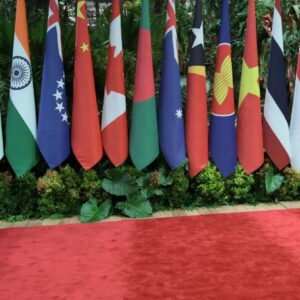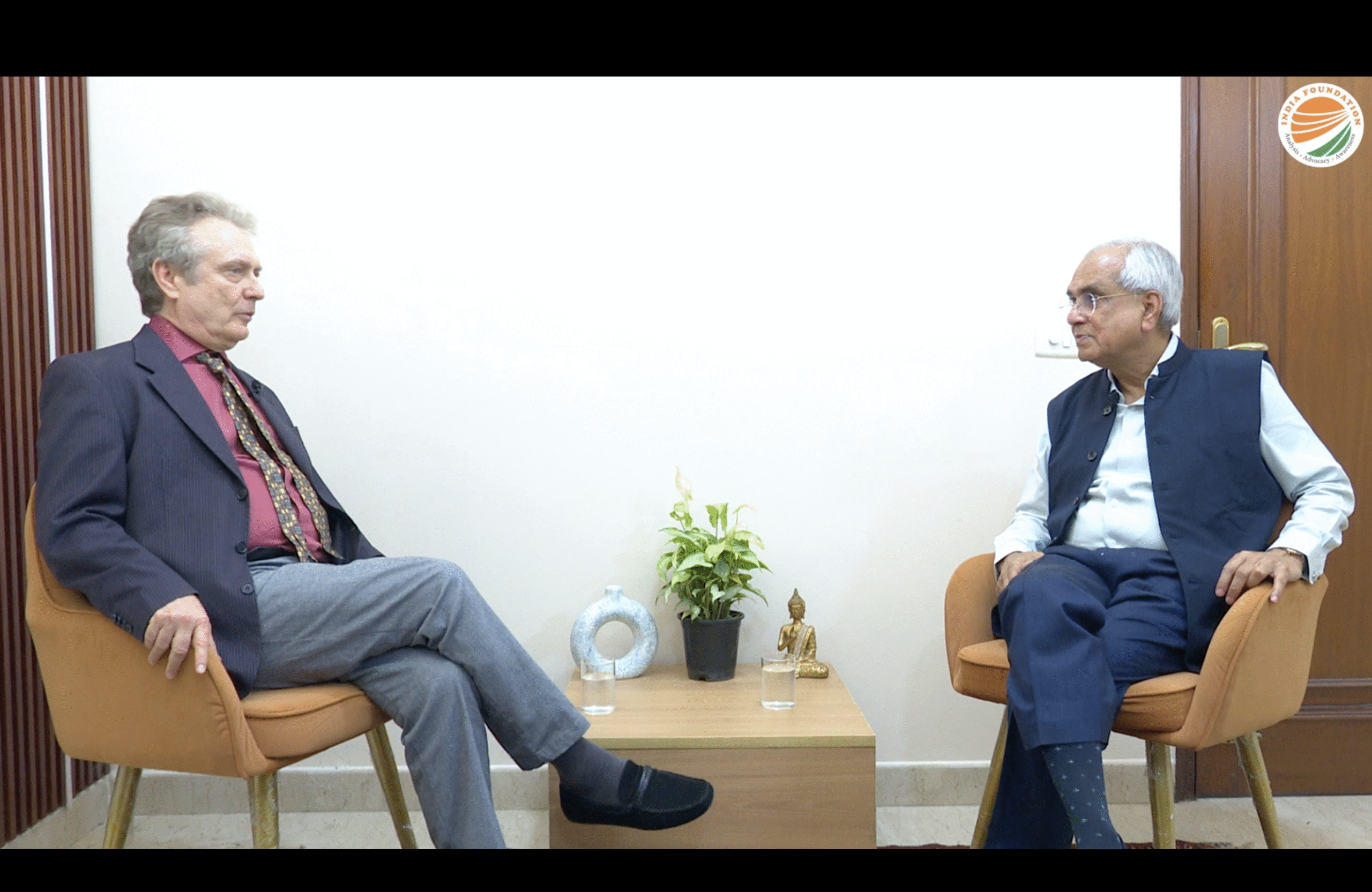Book: Our Constitution Our Pride
Author: Ram Madhav
Publication: Prabhat Prakashan
Year of Publication: 2025
Pages: 190
In the contemporary Indian political landscape, where constitutional debates frequently occupy centre stage, Ram Madhav’s monograph Our Constitution, Our Pride represents a substantial contribution to the discourse surrounding India’s foundational document. Published at a moment when the Indian Republic celebrates seventy-six years of constitutional governance, Madhav’s work offers a meticulously researched historical account that traces the evolution of the Indian Constitution from its conceptual origins through its implementation challenges. The volume navigates the complex interplay between constitutional theory and political practice, presenting a narrative that is both historically illuminating and contextually relevant to current constitutional deliberations.
Madhav starts his analysis by situating the Indian constitutional project within its historical context, demonstrating that the struggle for a constitution began not with the Constituent Assembly in 1946 but much earlier. In his references to President Murmu’s statement that the Constitution emerged from “our long freedom struggle”, the author effectively argues that constitutional aspirations were inherently woven into the independence movement. The detailed examination of early efforts, including opposition to the Government of India Act 1919 and Mahatma Gandhi’s reflections in Hind Swaraj (1909), offers significant historiographical insights that challenge the conventional periodisation of India’s constitutional history. This approach represents a notable shift from typical constitutional histories that often start with the Constituent Assembly deliberations, creating a more comprehensive genealogy of Indian constitutionalism that acknowledges its indigenous intellectual roots alongside its engagement with Western constitutional traditions.
The author’s treatment of the drafting process is notably nuanced, elucidating the intellectual contributions of various political figures while recognising the central role of Dr B.R. Ambedkar. Madhav carefully reconstructs the dialogic processes through which constitutional provisions were negotiated, revealing the complex ideological currents that influenced the final document. His thorough account of the eight committees established by the Constituent Assembly and the extensive deliberative process, comprising 7,635 amendments, 2,473 of which were discussed over 114 working days, provides readers with a nuanced understanding of constitution-making as an intellectually demanding collective endeavour. The biographical sketches of key figures like Ambedkar, who allegedly worked 18-hour days despite his poor health, humanise the constitutional project and highlight the personal sacrifices involved in its creation. This aspect of the narrative effectively counters reductionist views that attribute the Constitution solely to individual genius, instead portraying it as a synthesis of diverse intellectual traditions within Indian political thought.
Madhav’s examination of the Constitution’s core principles, which include democratic governance, an independent judiciary, and fundamental rights, displays significant theoretical depth. His investigation into how the founding generation understood these principles showcases a deep engagement with primary sources. His comparative analysis of Ambedkar’s and Gandhi’s distinct views on democracy highlights their mutual concern over unchecked majoritarianism, despite their perspectives offering different philosophical orientations. The author notes, “For Gandhi, democracy ensured the weak had the same opportunities as the strong. For Ambedkar, it involved amplifying the voices of the unheard.” This interpretive lens provides valuable insights for modern discussions on Indian democracy. Madhav’s meticulous reconstruction of these intellectual lineages allows readers to grasp the theoretical richness inherent in Indian constitutional thought while acknowledging its practical implications for institutional design.
The volume’s historical contextualisation extends beyond familiar narratives, incorporating lesser-known episodes such as Gandhi’s role in developing a constitution for the princely state of Aundh in 1939. Madhav documents how this experience, which emphasised decentralised governance, village panchayats, and fundamental rights, influenced subsequent constitutional thinking. Similarly, his analysis of the Nehru Report 1928, with its 22 chapters and 88 articles addressing fundamental rights, bicameralism, and federalism, illuminates an important but often overlooked chapter in Indian constitutional history. This archaeological approach to constitutional antecedents enriches our understanding of the intellectual ferment that preceded the Constituent Assembly’s work.
The examination of contentious constitutional issues showcases Madhav’s ability to engage with complex legal and political debates in a manner that is both scholarly and accessible. His discussion of Article 370, the Hindu Code Bill, the Uniform Civil Code, and other debated constitutional provisions offers readers a historically grounded understanding of these ongoing controversies. He maintains analytical rigour even when addressing politically charged subjects, presenting multiple perspectives before sharing his interpretations. His study of Ambedkar’s unsuccessful efforts to integrate the Hindu Code Bill into the constitutional framework, along with the subsequent legislative history of this reform, illustrates the intricate relationship between constitutional aspirations and legislative implementations.
In his chapter “Misuse of the Constitution”, Madhav offers a substantive critique of instances where constitutional mechanisms were used for partisan political purposes. His analysis of the misapplication of Article 356 (President’s Rule) and the declaration of Emergency in 1975 is particularly sharp. Drawing on primary sources and legal scholarship, he details how constitutional provisions intended as “dead letters” (in Ambedkar’s phrasing) were invoked to undermine democratic governance. This section represents one of the volume’s most significant contributions, assessing how constitutional provisions can be subverted without formal amendment. The thorough analysis of Indira Gandhi’s invocation of Article 356 fifty times during her tenure as Prime Minister provides an empirical foundation for theoretical discussions of constitutional subversion.
The chapter “Reform to Perform Better” warrants special attention for its engagement with contemporary debates about constitutional reform. Madhav thoughtfully examines various proposals, including those from the M.N. Venkatachaliah Commission established during Atal Bihari Vajpayee’s government. His discussion navigates the tension between constitutional adaptability and the “Basic Structure” doctrine established in the Kesavananda Bharati judgement. While acknowledging the need for reforms to address evolving societal needs, the author emphasises that any modifications must preserve the fundamental character of the Constitution. This nuanced position avoids uncritical constitutional veneration and cavalier reformism, suggesting principled incrementalism guided by constitutional teleology.
Madhav employs a predominantly historical-institutional approach, examining constitutional evolution through political developments and institutional dynamics. The extensive use of primary sources- including debates from the Constituent Assembly, correspondence between key figures, and parliamentary proceedings- represents a significant strength of this work. The inclusion of annexures featuring foundational speeches, such as Nehru’s address when moving the Objectives Resolution and Ambedkar’s speech on the adoption of the Constitution, grants readers direct access to seminal constitutional texts, thereby enhancing the volume’s value as a reference work. The methodological framework integrates legal formalism with historical contextualism, steering clear of both ahistorical textualism and reductionist political determinism. His work demonstrates substantial intellectual independence and scholarly integrity. His critiques of the misuse of constitutional provisions during various administrations reflect a commitment to constitutional principles that transcend partisan alignments. This intellectual honesty enhances the credibility of the work, even for readers who might not share all of the author’s normative orientations. The willingness to acknowledge constitutional failings across different political eras demonstrates an admirable commitment to scholarly objectivity.
The book’s concluding reflections on constitutional morality are particularly thought-provoking. It references Ambedkar’s assertion that constitutional morality is not an inherent attitude but requires cultivation. Madhav emphasises that the Constitution’s efficacy ultimately depends on adherence to constitutional principles and norms rather than merely formal compliance with the constitutional text. This insight resonates with contemporary scholarship on democratic backsliding and constitutional resilience, suggesting potential directions for future research on India’s constitutional trajectory. His invocation of American Supreme Court Justice Joseph Story’s warning further reinforces the essential relationship between constitutional institutions and civic culture.
The author’s prose is characterised by precision while remaining accessible, steering clear of both excessive technicality and overly simplistic generalisations. The synthesis of theoretical analysis with historical narrative results in a composition that is both intellectually robust and narratively compelling. The meticulous organisation of the content, alongside the strategic incorporation of primary sources, illustrates a degree of methodological rigour that is likely to resonate with academic audiences. The book significantly contributes to Indian constitutional scholarship by offering a comprehensive historical account and thoughtfully engaging with contemporary debates. It will prove invaluable to scholars of Indian constitutional history, legal scholars, political scientists, and engaged citizens seeking a deeper understanding of India’s constitutional foundations. Madhav’s commitment to historical precision and analytical nuance makes this book a worthy addition to constitutional literature.
Brief Bio: Dr. Manvi Singh is working as an Assistant Professor in Department of English at Sri Venkateswara College, University of Delhi.




